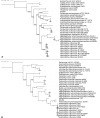The Genomic Sequence of the Oral Pathobiont Strain NI1060 Reveals Unique Strategies for Bacterial Competition and Pathogenicity
- PMID: 27409077
- PMCID: PMC4943601
- DOI: 10.1371/journal.pone.0158866
The Genomic Sequence of the Oral Pathobiont Strain NI1060 Reveals Unique Strategies for Bacterial Competition and Pathogenicity
Abstract
Strain NI1060 is an oral bacterium responsible for periodontitis in a murine ligature-induced disease model. To better understand its pathogenicity, we have determined the complete sequence of its 2,553,982 bp genome. Although closely related to Pasteurella pneumotropica, a pneumonia-associated rodent commensal based on its 16S rRNA, the NI1060 genomic content suggests that they are different species thriving on different energy sources via alternative metabolic pathways. Genomic and phylogenetic analyses showed that strain NI1060 is distinct from the genera currently described in the family Pasteurellaceae, and is likely to represent a novel species. In addition, we found putative virulence genes involved in lipooligosaccharide synthesis, adhesins and bacteriotoxic proteins. These genes are potentially important for host adaption and for the induction of dysbiosis through bacterial competition and pathogenicity. Importantly, strain NI1060 strongly stimulates Nod1, an innate immune receptor, but is defective in two peptidoglycan recycling genes due to a frameshift mutation. The in-depth analysis of its genome thus provides critical insights for the development of NI1060 as a prime model system for infectious disease.
Conflict of interest statement
Figures


Similar articles
-
Comparative phylogenies of the housekeeping genes atpD, infB and rpoB and the 16S rRNA gene within the Pasteurellaceae.Int J Syst Evol Microbiol. 2004 Sep;54(Pt 5):1601-1609. doi: 10.1099/ijs.0.03018-0. Int J Syst Evol Microbiol. 2004. PMID: 15388716
-
Development of a multiplex PCR assay based on the 16S-23S rRNA internal transcribed spacer for the detection and identification of rodent Pasteurellaceae.J Microbiol Methods. 2013 Nov;95(2):256-61. doi: 10.1016/j.mimet.2013.09.005. Epub 2013 Sep 18. J Microbiol Methods. 2013. PMID: 24055385
-
Phylogenetic relationships of unclassified, satellitic Pasteurellaceae obtained from different species of birds as demonstrated by 16S rRNA gene sequence comparison.Res Microbiol. 2009 Jun;160(5):315-21. doi: 10.1016/j.resmic.2009.05.006. Epub 2009 Jun 30. Res Microbiol. 2009. PMID: 19573597
-
Taxonomy of Histophilus somni.Curr Top Microbiol Immunol. 2016;396:1-14. doi: 10.1007/82_2015_5007. Curr Top Microbiol Immunol. 2016. PMID: 26847356 Review.
-
Genotyping to distinguish microbial pathogenicity in periodontitis.Periodontol 2000. 2010 Oct;54(1):136-59. doi: 10.1111/j.1600-0757.2010.00352.x. Periodontol 2000. 2010. PMID: 20712638 Review. No abstract available.
Cited by
-
Probiotic Streptococcus salivarius K12 Alleviates Radiation-Induced Oral Mucositis in Mice.Front Immunol. 2021 Jun 4;12:684824. doi: 10.3389/fimmu.2021.684824. eCollection 2021. Front Immunol. 2021. PMID: 34149727 Free PMC article.
-
Toll-like receptor-2 and -4 responses regulate neutrophil infiltration into the junctional epithelium and significantly contribute to the composition of the oral microbiota.J Periodontol. 2019 Oct;90(10):1202-1212. doi: 10.1002/JPER.18-0719. Epub 2019 Jul 1. J Periodontol. 2019. PMID: 31111967 Free PMC article.
-
Different engagement of TLR2 and TLR4 in Porphyromonas gingivalis vs. ligature-induced periodontal bone loss.Braz Oral Res. 2017 Aug 21;31:e63. doi: 10.1590/1807-3107BOR-2017.vol31.0063. Braz Oral Res. 2017. PMID: 28832712 Free PMC article.
References
-
- Marsh PD. Role of the Oral Microflora in Health. Microbial Ecology in Health and Disease. 2000. pp. 130–137. 10.1080/089106000750051800 - DOI
MeSH terms
Substances
Grants and funding
LinkOut - more resources
Full Text Sources
Other Literature Sources
Molecular Biology Databases

